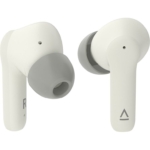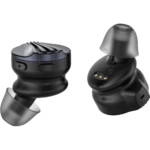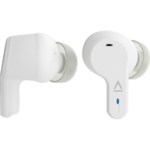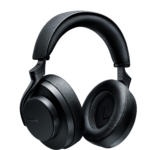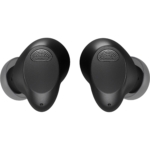Google’s Pixel Buds Pro debut made a mixed impression. At a price of just under 220 euros, there are simply too many things missing for us to give them a resounding recommendation: The lack of configuration options via the app, the inaccurate ear insert fit test and the lack of high-quality and low-latency Bluetooth codecs, including a newer, power-saving Bluetooth version. Even if the lack of an equaliser or the spatial audio functionality will be addressed soon – other manufacturers offer more features for less money, or even for just a little more money.
If you’re a Google fan or a heavy user of Google services (Assistant, Translate), the Google Pixel Buds Pro might be just the right productivity tool to help you cope with everyday life.
For the moment, though, the “Pro” in the name does not yet stand for “Professional” to our eyes or ears. But who knows: As soon as Google adds the missing functions via a firmware update, we will repeat the test – perhaps then we will then give them a recommendation.
- Comfortable to wear
- Charging case with IPX2 certification
- Noise cancelling
- SBC and AAC only
- Bluetooth 5.0
- Few configuration options
Google goes Pro: With its new Google Pixel Buds Pro, the tech company wants to play in the same league as Apple’s AirPods Pro or Samsung’s Galaxy Buds 2 Pro. The search engine giant has equipped its new True Wireless in-ears with active noise cancellation (ANC) and transparency mode and wants to create an experience specially tailored to owners of Android smartphones with all kinds of additional services. Whether Google succeeds in this and whether the Pixel Buds rightly bear the abbreviation “Pro” as in “Professional”, we will clarify with our detailed test.
Design
Compared to the Pixel Buds A Series launched in 2021, the matte white charging case is now slightly larger. This is IPX2 certified and thus protected against drops of water, while the Buds themselves are rated IPX4. The case can be opened easily with one hand. The in-ears, which are available in a choice of four colours, are magnetically locked in to prevent them from accidentally falling out. The most obvious difference to the Google Pixel Buds A-Series is the shape of the small button headphones: The Pro do without the stabilising ear fins, while at the same time, their design is slightly chunkier and reminiscent of a cross between a chewy sweet and a bean.
Package
The Google Pixel Buds Pro come with three different earpieces (S, M, L), the wirelessly chargeable case and a Quick Start Guide. A USB charging cable is not included and can be purchased separately. This may seem unusual at first glance, but it saves valuable resources, especially since, by now, almost everyone should have a USB-C cable lying around at home.
Comfort
The Google Pixel Buds fit extremely comfortably in the ears. Their slightly chunky shape nestles comfortably into the ear cups, allowing a cap to be worn without feeling too much pressure. As comfortable as they are, they do tend to slip due to their bean-shaped design and smooth surfaces. During walks with the dog or short sprints, we had to intervene more than once to correct the fit. Another point of criticism: Although Google, like other providers, only supplies three pairs of earplugs, this selection is not sufficient for the Pixel Buds Pro. We found that the fit test via a smartphone always indicated that the headphones did not fit properly. However, when another person tried the fit test, it always confirmed a correct fit, regardless of which size was selected. Therefore, there’s no way to say how valid the results of this test actually are. Thanks to the IPX4 certification already mentioned, in principle, the Pixel Buds Pro are suitable for sporting activities, but since they sit quite loosely in the ears, active athletes might be better off reaching for other models.
Operation
Thanks to their touch surfaces, the Google Pixel Buds Pro can be reliably controlled, with the left and right in-ears being identically assigned. Different tapping gestures control playback, calls and track changes while holding down deactivates/activates ANC, transparency mode and Google Assistant. Google has added a special feature to its Buds Pro: The volume can be changed with a swipe gesture, but not – as one would expect – from bottom to top, but from front to back (and the other way around). We give this a thumbs up as it’s good to have the possibility to change the volume directly on the earphones, but most manufacturers do not implement this extremely practical function. Another useful feature is the auto-pause function which kicks in when the earphones are removed and resumes playback when they are reinserted. In addition, the Pixel Buds Pro work in mono mode (single mode). Unfortunately, the Google Pixel Buds Pro cannot suppress tapping noises when tapping on the touch fields.
If you want to change the touch control, though, you will be disappointed: This is simply not possible. Seeing as Google allows you to change almost everything in the Android cosmos, this is a rather unusual point. With the Pixel Buds Pro, for example, you can only deactivate/activate wear recognition, decide whether all three listening modes (ANC, transparency, both off) should be controllable and whether the left, right or both in-ears should launch Google Assistant.
Bluetooth
Thanks to Google Fast Fair, pairing is quick and convenient, provided your smartphone (Android 6.0 or higher) offers this feature. Otherwise, the conventional route must be taken to put the Google Pixel Buds Pro into pairing mode by pressing the button on the back of the case. Both worked without problems in our tests with Pixel and Apple smartphones.
Unfortunately, Google (like Apple with its AirPods [to an overview]) relies on rather conventional Bluetooth codecs: With SBC and AAC as well as the older Bluetooth 5.0, the potential is being wasted: Qualcomm’s aptX family would be more appreciated here because without a low-latency codec, there can be a noticeable delay between picture and sound. In addition, AAC does not work with the same high quality on all Android devices.
But the in-ears do support multipoint, i.e. the simultaneous connection of two devices.
Battery life
The battery life of these True Wireless in-ears is not industry-leading, but with up to eleven hours of playback without ANC and seven hours with ANC, the Pixel Buds Pro are in the medium range. A decent figure nonetheless. If you need more endurance, take a look at the Audio-Technica ATH-CKS50TW or Creative Outlier Pro, which boast runtimes of 20 and 18 hours respectively.
The case, which can be charged via USB-C or wirelessly (Qi-certified), can deliver another 20 hours, while a five-minute quick charge provides up to 60 minutes of playtime.
Pixel Buds App
If you do not own a Pixel smartphone, you can download a special app from the Google Play Store. If you do have a Pixel smartphone, this application is already integrated into the system settings. As already mentioned above, the app offers relatively few configuration options: Installing firmware updates, checking the fit of the earpieces, switching multipoint or deactivating/activating the touch control. But here, of course, you can also set up Google Assistant or use the find function if the headphones have been misplaced.
“Volume EQ” is a new menu item. This optimises the bass and treble at low volume so that these frequency ranges do not “dull” as usual. This works very well in practice, and even at low volume, the overall impression appears similarly powerful as at normal playback volumes.
Google Pixel Buds Pro and Apple
If your fleet consists purely of Apple devices, then you must do without an app and can neither install firmware updates nor adjust settings. So you have to live with the standards, and the practical real-time Google translation function only works by installing the corresponding app from the iOS Store. But this does not necessarily require Google headphones.
Thanks to Multipoint, however, it is still possible to listen to music via iOS while managing, configuring and switching via Android.
For Apple users, however, there are better alternatives, and if you like to use headphones that are similarly deeply rooted in the operating system, then you should try the Apple as well as Beats headphones (our review) in your ears.
Noise cancelling and transparency mode
While the Pixel Buds A-Series only had an adaptive sound function that adjusts the sound to different environments, the new Pro have active noise cancellation. So instead of automatically adjusting the volume to suppress ambient noise, the Pixel Buds Pro’s ANC detects it and suppresses it. Fortunately, Google provides its noise-cancelling debut small ventilation openings. This eliminates the unpleasant diving bell effect and pressure in the ear. However, external noise doesn’t “disappear” when ANC is activated: The noise cancelling doesn’t work as intensively as that of the Apple AirPods Pro or the Sony WF-1000XM4. Low frequencies are reduced accordingly, while mid and high signal components are only slightly attenuated.
A background noise is clearly audible but loses strength as soon as media content is played. This also applies to the transparency mode, which unfortunately sounds a little musty and lacks naturalness.
Sound
Google has installed eleven-millimetre dynamic drivers in its Pixel Buds Pro, but the manufacturer is silent about their frequency response. With our test tracks, which cover many genres, unfortunately, there was a lot to complain about, because the tuning was somewhat “distorted”. The bass sounded exaggerated, which was certainly desirable for modern styles. Thus, the Google Pixel Buds Pro “thicken” music tracks considerably at the bottom: Although tonalities remained detectable, certain bass drums or instruments tended to boom at higher volume levels.
The lower mids, on the other hand, seem to be subdued. As a result, rhythm guitars, synthesisers and lower voices seemed subordinate, especially in dense arrangements, and lost their boldness.
This was also due to the trebles, which were also raised, but in turn, lacked brilliance. This can result in certain sibilants being perceived as cutting (Grace Jones “Slave To The Rhythm”) and hi-hats, crash cymbals or other percussion instruments as too loud.
In terms of stereo width and depth, the Google Pixel Buds Pro do not stand out. The virtual stage in the head was narrow, but moving sound events could still be clearly tracked.
In terms of sound features, the Google Pixel Buds Pro are also a bit lacking. At the time of this test, three functions were missing, but according to the manufacturer, they will be added this autumn. The spatial audio with head tracking familiar from Apple’s headphones is also supposed to be added, although it can be assumed that this will not work on iOS devices. Google also plans to add a five-band equaliser and a volume balance that changes the ratio of the left and right channels and switches both headphones to mono.
Calling
For each side, Google has installed three microphones so that the voice is transmitted clearly and distinctly. We can confirm this worked under quiet home office conditions and the Buds also made a good impression during video conferences. As soon as we went outside, the picture changed. These headphones have problems with strong wind noise, and your own voice sounds clipped and garbled. Background noises don’t stand out very much, but the other person can still hear them while your own voice remains audible.
Technical specifications
- Ear couplingIn-ear
- Typeclosed
- Transducer principledynamic
- Weight without cable6,2 g each, case 50 g
What's in the box
- 3 pairs of ear tips (S, M, L)
- Charging case
Special features
- Available in dark grey, light grey, orange and green/yellow
- BT codecs: SBC, AAC
- BT version: 5.0








